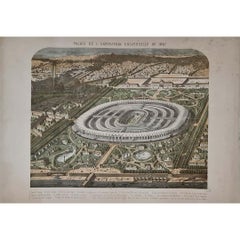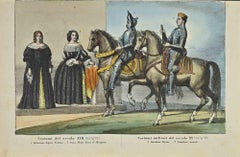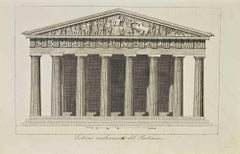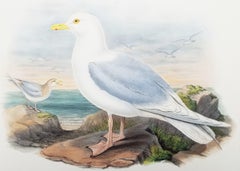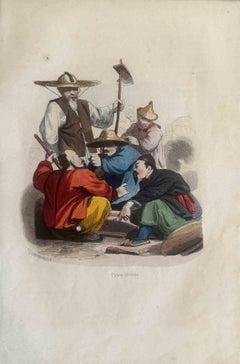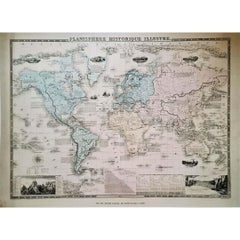1860s Art
to
75
879
180
58
42
32
Overall Width
to
Overall Height
to
7,471
21,059
159,720
233,443
1,944
2,225
4,780
6,393
5,834
14,911
20,289
25,384
17,597
13,624
5,304
732
51
30
6
3
1
646
511
5
861
441
335
249
232
197
138
94
71
65
55
52
49
49
47
46
46
40
38
37
652
205
189
155
82
31
11
10
6
6
195
751
689
248
Period: 1860s
1867 original lithography for the Exposition Universelle in Paris
Located in PARIS, FR
The 1867 Exposition Universelle in Paris was one of the grandest World’s Fairs of the 19th century, showcasing industrial progress, cultural achievements, and artistic excellence. Th...
Category
1860s Art
Materials
Paper, Lithograph
Costumes of the 17th century - Lithograph - 1862
Located in Roma, IT
Costumes of the 17th century is a lithograph on paper realized in 1862.
The artwork belongs to the Suite Uses and customs of all the peoples of the universe: " History of the govern...
Category
Modern 1860s Art
Materials
Lithograph
Exterior of the Parthenon - Lithograph - 1862
Located in Roma, IT
Exterior of the Parthenon is a lithograph on paper realized in 1862.
The artwork belongs to the Suite Uses and customs of all the peoples of the universe: " History of the governmen...
Category
Modern 1860s Art
Materials
Lithograph
Larus Islandicus (Iceland Gull) /// John Gould Ornithology Bird Animal Litho Art
By John Gould
Located in Saint Augustine, FL
Artist: John Gould (English, 1804-1881)
Title: "Larus Islandicus (Iceland Gull)" (Vol. 5, Plate 58)
Portfolio: The Birds of Great Britain
Year: 1862-1873
Medium: Original Hand-Colored Lithograph on wove paper
Limited edition: approx. 750
Printer: Walter or Walter & Cohn, London, UK
Publisher: Taylor and Francis, John Gould, London, UK
Reference: Sauer No. 23; Ayer/Zimmer page 261; Wood page 365; Nissen No. IVB 372; Sitwell page 78
Sheet size: 14.57" x 21.57"
Image size: 12" x 16.25"
Condition: Soft handling creases to sheet. Remnants of mounting tape from previous framing at top on verso. In excellent condition with strong colors
Notes:
Provenance: private collection - Mount Vernon, IA. Lithography and hand-coloring by German artist Joseph Wolf (1820-1899) and Irish artist William Hart (1830-1908). Comes from Gould's five volume "The Birds of Great Britain", (1862-1873) (First edition), which consists of 367 hand-colored lithographs. Other contributing lithographers were John Gould and English artist Henry Constantine Richter (1821-1902) "The Birds of Great Britain" is recognized as Gould's greatest work. Comes with its original accompanying text page. Gold gilded edges as issued.
The Iceland gull is a medium-sized gull that breeds in the Arctic regions of Canada and Greenland, but not in Iceland, where it is only seen during winter. The genus name is from Latin larus, which appears to have referred to a gull or other large seabird.
Biography:
John Gould FRS (14 September 1804 – 3 February 1881) was an English ornithologist and bird artist. He published a number of monographs on birds, illustrated by plates that he produced with the assistance of his wife, Elizabeth Gould, and several other artists including Edward Lear, Henry Constantine Richter, Joseph Wolf and William Matthew Hart. He has been considered the father of bird study in Australia and the Gould League in Australia is named after him. His identification of the birds now nicknamed "Darwin's finches" played a role in the inception of Darwin's theory of evolution by natural selection. Gould's work is referenced in Charles Darwin's book, "On the Origin of Species".
Category
Victorian 1860s Art
Materials
Watercolor, Lithograph
Uses and Customs - Chinese - Lithograph - 1862
Located in Roma, IT
Uses and Customs - Chinese is a lithograph on paper realized in 1862.
The artwork belongs to the Suite Uses and customs of all the peoples of the universe: " History of the governme...
Category
Modern 1860s Art
Materials
Lithograph
1864 Original illustrated planisphere - World Map - Geography
Located in PARIS, FR
Immerse yourself in the epic journey of the past with the Illustrated Historical Planisphere of 1864 by Charpentier! 🗺️ This cartographic treasure transports you through the intrica...
Category
1860s Art
Materials
Linen, Lithograph, Paper
Uses and Customs - Italian Army - Lithograph - 1862
Located in Roma, IT
Uses and Customs - Italian Army is a lithograph on paper realized in 1862.
The artwork belongs to the Suite Uses and customs of all the peoples of the universe: " History of the gov...
Category
Modern 1860s Art
Materials
Lithograph
Rue Galande - Fine 19th Century French Paris Street Antique Watercolour Painting
Located in Sevenoaks, GB
A fine signed and dated 1868 watercolour and pencil on laid paper depicting a bustling scene on Rue Galande in the 5th arrondissement of Paris, by Alfred-Alexandre Delauney. Excellen...
Category
1860s Art
Materials
Watercolor, Laid Paper, Pencil
Golden Winged Woodpecker by J.J. Audubon Bien Edition 1860
Located in Paonia, CO
The Golden Winged Woodpecker, Plate 273 Picus auratus, Linn. The current name, Northern Flicker, Colaptes auratus. is in good condition. The edges are ragged from age with small areas of paper missing in two places but only on the very edge.
The ” Birds of America” by John James...
Category
Other Art Style 1860s Art
Materials
Lithograph
Le Pere Malice - Etching by Jules Jacques Veyrassat - 1860s
Located in Roma, IT
Le Pere Malice is a black and White etching realized by Jules Jacques Veyrassat in the 1860s.
Titled in the lower
Image Size: 24x32
Very good impression.
Realized for the "Socié...
Category
Modern 1860s Art
Materials
Etching
Torment of the Collar - Costumes - Lithograph - 1862
Located in Roma, IT
Torment of the Collar - Costumes is a Hand-colored lithograph on paper realized in 1862.
The artwork belongs to the Suite Uses and customs of all the peoples of the universe: " Hist...
Category
Modern 1860s Art
Materials
Lithograph
Giuseppe Garibaldi - Lithograph by Antonio Masutti - 1860
Located in Roma, IT
Garibaldi is a rare original Colored Lithograph, realized by Antonio Masutti in the 1960.
The status of preservation Good.
The artwork is depicted skillfully through confident and ...
Category
Modern 1860s Art
Materials
Lithograph
Uses and Customs - Dance in feast of Diana - Lithograph - 1862
Located in Roma, IT
Uses and Customs - Dance in feast of Diana is a lithograph on paper realized in 1862.
The artwork belongs to the Suite Uses and customs of all the peoples of the universe: " History...
Category
Modern 1860s Art
Materials
Lithograph
Repos - Etching by Auguste Mathieu - 1860s
Located in Roma, IT
Repos is a black and White etching realized by Auguste Mathieu in the 1860s.
Titled in the lower.
Image size: 24x32.
Very good impression with wide margins and a very fresh inkin...
Category
Modern 1860s Art
Materials
Etching
Uses and Customs - Saints - Lithograph - 1862
Located in Roma, IT
Uses and Customs - Saints is a lithograph on paper realized in 1862.
The artwork belongs to the Suite Uses and customs of all the peoples of the universe: " History of the governmen...
Category
Modern 1860s Art
Materials
Lithograph
Example of Doric Proportion - Lithograph - 1862
Located in Roma, IT
Example of Doric Proportion is a lithograph on paper realized in 1862.
The artwork belongs to the Suite Uses and customs of all the peoples of the universe: " History of the governm...
Category
Modern 1860s Art
Materials
Lithograph
Nasereddin Shah, King of Persia and his Soldiers- Lithograph - 1862
Located in Roma, IT
Persian Cloth in 19th Century is a Hand-colored lithograph on paper realized in 1862.
The artwork belongs to the Suite Uses and customs of all the peoples of the universe: " History...
Category
Modern 1860s Art
Materials
Lithograph
Italian Celebrities of 16th Century - Lithograph - 1862
Located in Roma, IT
Italian Celebrities of 16th Century is a lithograph on paper realized in 1862.
The artwork belongs to the Suite Uses and customs of all the peoples of the universe: " History of the...
Category
Modern 1860s Art
Materials
Lithograph
Uses and Customs - Antonine Column - Lithograph - 1862
Located in Roma, IT
Uses and Customs - Antonine Column is a lithograph on paper realized in 1862.
The artwork belongs to the Suite Uses and customs of all the peoples of the universe: " History of the...
Category
Modern 1860s Art
Materials
Lithograph
Un Rocher dans les Communaux de Rix - Etching by Appian - 1860s
Located in Roma, IT
Un Rocher dans les Communaux de Rix is a black and White etching realized by A. Appian in the 1860s.
Titled in the lower.
Image size: 8 x 13, 8 x 12, 16 x 27
Very good impression...
Category
Modern 1860s Art
Materials
Etching
Uses and Customs - La Pons - Lithograph - 1862
Located in Roma, IT
Uses and Customs - La Pons is a lithograph on paper realized in 1862.
The artwork belongs to the Suite Uses and customs of all the peoples of the universe: " History of the governme...
Category
Modern 1860s Art
Materials
Lithograph
Propylaea - Lithograph - 1862
Located in Roma, IT
Propylaea is a lithograph on paper realized in 1862.
The artwork belongs to the Suite Uses and customs of all the peoples of the universe: " History of the government, of the laws, ...
Category
Modern 1860s Art
Materials
Lithograph
Cerfs en Foret - Etching by Théophile Narcisse Chauvel - 1860s
Located in Roma, IT
Cerfs en Foret is a black and White etching realized by Théophile Narcisse Chauvel in the 1860s.
Titled in the lower.
Image size: 24x31.
Very good impression with wide margins a...
Category
Modern 1860s Art
Materials
Etching
Costumes of the 13th and 14th centuries - Lithograph - 1862
Located in Roma, IT
Costumes of the 13th and 14th centuries is a lithograph on paper realized in 1862.
The artwork belongs to the Suite Uses and customs of all the peoples of the universe: " History of...
Category
Modern 1860s Art
Materials
Lithograph
Uses and Customs - the Customs in Venice - Lithograph - 1862
Located in Roma, IT
Uses and Customs - the Customs in Venice is a lithograph on paper realized in 1862.
The artwork belongs to the Suite Uses and customs of all the peoples of the universe: " History o...
Category
Modern 1860s Art
Materials
Lithograph
Interior of the Odeum of Pericles - Lithograph - 1862
Located in Roma, IT
Interior of the Odeum of Pericles is a lithograph on paper realized in 1862.
The artwork belongs to the Suite Uses and customs of all the peoples of the universe: " History of the g...
Category
Modern 1860s Art
Materials
Lithograph
Paris : Stock Market Place - Original stone lithograph
Located in Paris, IDF
Philippe BENOIST
Paris : Stock Market Place - 1861
Original two tones stone lithographs
Printed name of the artist bottom right
On vellum 33.5 x 49 cm (c...
Category
Realist 1860s Art
Materials
Lithograph
Uses and Customs - Ducal Palace in Venice - Lithograph - 1862
Located in Roma, IT
Uses and Customs - Ducal Palace in Venice is a lithograph on paper realized in 1862.
The artwork belongs to the Suite Uses and customs of all the peoples of the universe: " History ...
Category
Modern 1860s Art
Materials
Lithograph
Etretat - Etching by Lèon Gaucherel - 1860s
Located in Roma, IT
Etretat is a black and White etching realized by Léon Gaucherel in the 1860s.
Titled in the lower
Image Size: 23x31
Very good impression.
Realized for the "Société des Aquaforti...
Category
Modern 1860s Art
Materials
Etching
Uses and Customs - Indian Dancer - Lithograph - 1862
Located in Roma, IT
Uses and Customs - Indian Dancer is a lithograph on paper realized in 1862.
The artwork belongs to the Suite Uses and customs of all the peoples of the universe: " History of the go...
Category
Modern 1860s Art
Materials
Lithograph
Les Métamorphoses du Jour - Rare Book Illustrated by J. J. Grandville - 1869
Located in Roma, IT
Les Métamorphoses du Jour is an original modern rare book written by Various Authors and illustrated by Jean Jacques Grandville (Nancy, 1803 – ...
Category
Modern 1860s Art
Materials
Paper, Watercolor, Lithograph
Palazzo Dario, Venice
Located in New York, NY
A classic and elegant Venetian view with a period Barbizon, gold leaf frame! Sheppard did a series of these and two other American painter is more noted for their Venetian views than...
Category
Realist 1860s Art
Materials
Oil
The Monument - Lithograph - 1862
Located in Roma, IT
The Monument is a lithograph realized in 1864.
Good conditions.
The artwork belongs to the Suite Uses and customs of all the peoples of the universe, or History of the government,...
Category
Modern 1860s Art
Materials
Lithograph
Villeneuve la Carenne - Etching by Alfred Taiée - 1860s
Located in Roma, IT
Villeneuve la Carenne is a black and White etching realized by Alfred Taiée in the 1860s.
Titled in the lower.
Image size: 10x28.
Very good impression with wide margins and a ver...
Category
Modern 1860s Art
Materials
Etching
"Bantam Rooster w/Hen and Chick" by Matthieu Theeuwes van Ginneken (1811-1888)
Located in SANTA FE, NM
"Bantam Rooster w/Hen and Chick"
Matthieu Theeuwes van Ginneken (1811-1888)
Oil on canvas mounted on wood panel
11 x 9 1/2 (18 x 16 1/2 x 3 inches frame) inches
Matthieu Theeuwes v...
Category
Realist 1860s Art
Materials
Canvas, Oil, Wood Panel
Uses and Customs - Cathedral Square in Florence - Lithograph - 1862
Located in Roma, IT
Uses and Customs - Cathedral Square in Florence is a lithograph on paper realized in 1862.
The artwork belongs to the Suite Uses and customs of all the peoples of the universe: " Hi...
Category
Modern 1860s Art
Materials
Lithograph
Uses and Customs - Saint Clement Basilica of Rome - Lithograph - 1862
Located in Roma, IT
Uses and Customs - Saint Clement Basilica of Rome is a lithograph on paper realized in 1862.
The artwork belongs to the Suite Uses and customs of all the peoples of the universe: " ...
Category
Modern 1860s Art
Materials
Lithograph
Italian Celebrities of 16th Century - Lithograph - 1862
Located in Roma, IT
Italian Celebrities of 16th Century is a lithograph on paper realized in 1862.
The artwork belongs to the Suite Uses and customs of all the peoples of the universe: " History of the...
Category
Modern 1860s Art
Materials
Lithograph
Customs - Achaemenid Kings Costume - Lithograph - 1862
Located in Roma, IT
Customs - Achaemenid Kings Costume is a lithograph on paper realized in 1862.
Titled on the lower.
The artwork belongs to the Suite Uses and customs of all the peoples of the unive...
Category
Modern 1860s Art
Materials
Lithograph
Great Salon in Padua - Lithograph - 1862
Located in Roma, IT
Uses and Customs - Great Salon in Padua is a lithograph on paper realized in 1862.
The artwork belongs to the Suite Uses and customs of all the peoples of the universe: " History of...
Category
Modern 1860s Art
Materials
Lithograph
Y se le quema la casa - Etching by Francisco Goya - 1868
Located in Roma, IT
Y se le quema la casa is an original artwork realized by the artist Francisco Goya and published for the first time in 1799.
Etching on paper.
The etching is part of the Third Edit...
Category
Old Masters 1860s Art
Materials
Etching, Aquatint
Sapeurs- Pompiers De Paris, Armee de Ligne pub. Lemercier lithograph 1861
Located in Paonia, CO
Sapeurs- Pompiers De Paris, Officier et Soldat ( Grandes Tenures).... Fire Brigade In Paris, Officer and Soldier (Large Tenure ) shows two mustachioed French soldiers from the A...
Category
1860s Art
Materials
Lithograph
Uses and Customs - Pompey Column, Cleopatra Obelisk - Lithograph - 1862
Located in Roma, IT
Uses and Customs - Pompey Column, Cleopatra Obelisk is a lithograph on paper realized in 1862.
The artwork belongs to the Suite Uses and customs of ...
Category
Modern 1860s Art
Materials
Lithograph
En Campagne - Etching by Auguste Lancon - 1860s
Located in Roma, IT
En Campagne is a black and White etching realized by Auguste Lancon in the 1860s.
Titled in the lower.
Image size: 12x8, 11x10.
Very good impression with wide margins and a very ...
Category
Modern 1860s Art
Materials
Etching
Uses and Customs - Cochinchinois - Lithograph - 1862
Located in Roma, IT
Uses and Customs - Cochinchinois is a lithograph on paper realized in 1862.
The artwork belongs to the Suite Uses and customs of all the peoples of the universe: " History of the go...
Category
Modern 1860s Art
Materials
Lithograph
Uses and Customs - Guesser - Lithograph - 1862
Located in Roma, IT
Uses and Customs - Guesser is a lithograph on paper realized in 1862.
The artwork belongs to the Suite Uses and customs of all the peoples of the universe: " History of the governme...
Category
Modern 1860s Art
Materials
Lithograph
Boy and Girl, Hand-Colored Lithograph by Currier & Ives
Located in Long Island City, NY
Artist: Currier and Ives
Title: Boy and Girl
Year: circa 1863
Medium: Hand-colored lithograph
Size: 11 x 8 in. (27.94 x 20.32 cm)
Frame Size: 16 x 14 inches
Category
Victorian 1860s Art
Materials
Lithograph
$600 Sale Price
20% Off
En Bretagne - Etching by David Sutter - 1860s
Located in Roma, IT
En Bretagne is a black and White etching realized by David Sutter in the 1860s.
Titled in the lower.
Image size: 21x31.
Very good impression with wide margins and a very fresh in...
Category
Modern 1860s Art
Materials
Etching
Portrait of Giuseppe Garibaldi - Photograph by C. Bernieri - Late 19th century
Located in Roma, IT
Portrait of Giuseppe Garibaldi is a precious Silver Salt print on paper, realized by Cesare Bernieri in 1861-1864.
Hand-signed and stamped on the lower.
E...
Category
Modern 1860s Art
Materials
Paper, Silver Gelatin
Uses and Customs - Ostia Castle - Lithograph - 1862
Located in Roma, IT
Uses and Customs - Ostia Castle is a lithograph on paper realized in 1862.
The artwork belongs to the Suite Uses and customs of all the peoples of the universe: " History of the gov...
Category
Modern 1860s Art
Materials
Lithograph
Uses and Customs - Interior of the Cathedral of Milan - Lithograph - 1862
Located in Roma, IT
Uses and Customs - Interior of the Cathedral of Milan is a lithograph on paper realized in 1862.
The artwork belongs to the Suite Uses and customs of all the peoples of the universe...
Category
Modern 1860s Art
Materials
Lithograph
Galeazzo Visconti - Lithograph - 1862
Located in Roma, IT
Galeazzo Visconti is a lithograph on paper realized in 1862.
The artwork belongs to the Suite Uses and customs of all the peoples of the universe: " History of the government, of th...
Category
Modern 1860s Art
Materials
Lithograph
Italian Costumes of the 17th century - Lithograph - 1862
Located in Roma, IT
Italian Costumes of the 17th century is a lithograph on paper realized in 1862.
The artwork belongs to the Suite Uses and customs of all the peoples of the universe: " History of th...
Category
Modern 1860s Art
Materials
Lithograph
Las Rinde el Sueño - Etching by Francisco Goya - 1868
Located in Roma, IT
Las rinde el Sueño is an original etching realized by Francisco Goya and published for the first time in 1799.
Original etching on paper.
This amazing Etchi...
Category
Old Masters 1860s Art
Materials
Etching, Aquatint
Vue de Saragosse - Etching by Henry Charles Landrin - 1860s
Located in Roma, IT
Vue de Saragosse is a black and White etching realized by Henry Charles Landrin in the 1860s.
Titled in the lower.
Image size: 17x32.
Very good impression with wide margins and a...
Category
Modern 1860s Art
Materials
Etching
Uses and Customs -Caesars - Lithograph - 1862
Located in Roma, IT
Uses and Customs -Caesars is a lithograph on paper realized in 1862.
The artwork belongs to the Suite Uses and customs of all the peoples of the universe: " History of the governmen...
Category
Modern 1860s Art
Materials
Lithograph
Moulins dans le pas de Calais - Etching by A. Sogé - 1860s
Located in Roma, IT
Moulins dans le pas de Calais is a black and White etching realized by A. Sogé in the 1860s.
Titled in the lower.
Image size: 23x31.
Very good impression with wide margins and a ...
Category
Modern 1860s Art
Materials
Etching
No Hay Quien lo Socorra - Etching by Francisco Goya - 1863
Located in Roma, IT
No hay quien lo socorra is an original artwork realized by the great Spanish artist Francisco Goya in 1810.
Original Etching on paper.
The artwork belongs to the famous series "L...
Category
Old Masters 1860s Art
Materials
Etching, Aquatint
Temple of Augustus in Pula - Lithograph - 1862
Located in Roma, IT
Uses and Customs - Temple of Augustus in Pula is a lithograph on paper realized in 1862.
The artwork belongs to the Suite Uses and customs of all the peoples of the universe: " Hist...
Category
Modern 1860s Art
Materials
Lithograph
Uses and Customs - Chinese - Lithograph - 1862
Located in Roma, IT
Uses and Customs - Chinese is a lithograph on paper realized in 1862.
The artwork belongs to the Suite Uses and customs of all the peoples of the universe: " History of the governme...
Category
Modern 1860s Art
Materials
Lithograph
